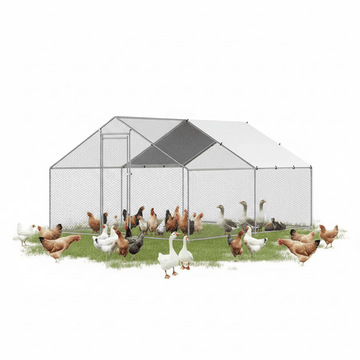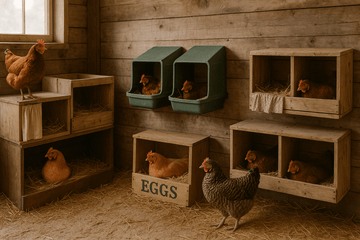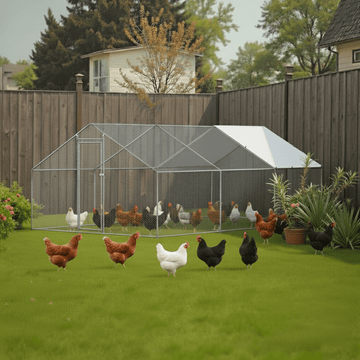You’ve built the coop, bought the feed, and lovingly cared for your hens—but the nesting boxes are empty. Sound familiar? For many backyard chicken keepers, it can be incredibly frustrating when hens stop laying or never start at all. While it’s easy to assume something’s seriously wrong, the truth is most egg-laying issues come down to a few common—and easily fixable—mistakes.
This guide explores the five biggest reasons your chickens might not be laying eggs. Whether you’re a newbie or a seasoned poultry owner, spotting and correcting these issues can make all the difference between an empty basket and a steady stream of fresh, delicious eggs.
Mistake #1: Inadequate Nutrition
Lack of Protein and Essential Nutrients
Egg production is one of the most demanding tasks a hen’s body can perform. It requires a precise balance of proteins, vitamins, minerals, and fats. If your hens aren’t laying, there’s a good chance their diet is falling short—especially in protein.
Laying hens need at least 16–18% protein in their daily diet to produce eggs consistently. Protein helps build the egg itself (yolk and white) and supports overall reproductive health. If your hens are free-ranging, they may not be getting enough of it, especially in colder months when bugs and greenery are scarce.
A deficiency in essential nutrients like Vitamin D, B-complex, selenium, and phosphorus can also lead to poor egg development or complete stoppage. These are often overlooked in commercial feed blends, especially low-grade brands.
The Importance of Calcium and Balanced Diet
Calcium is crucial—not just for shell strength, but for the actual mechanics of laying an egg. Without enough calcium, hens may lay thin-shelled or shell-less eggs, or stop laying altogether. Worse, they’ll begin pulling calcium from their own bones, leading to health problems.
Free-choice oyster shells, crushed eggshells, or calcium-enriched feed can help maintain proper levels. Just as important is the balance of nutrients. Feeding too many treats like corn or kitchen scraps without adjusting protein or calcium intake can throw everything out of whack.
Best Natural Feed Enhancers
Want to go beyond commercial feed? Try these:
- Pumpkin seeds: Great for protein and natural deworming
- Mealworms: High in protein and energy
- Sunflower seeds: Rich in vitamin E and healthy fats
- Flaxseeds: Adds omega-3s for better yolks
- Alfalfa pellets: Boosts vitamin and calcium intake
Add these gradually and track results. With the right fuel, your hens will get back on track in no time.
Mistake #2: Insufficient Light Exposure
The Role of Daylight in Egg Production
Egg laying is closely tied to photoperiod—the amount of light a hen is exposed to each day. Hens typically need 14–16 hours of light daily to maintain regular laying. When daylight hours decrease in the fall and winter, their internal clocks signal that it’s time to take a break.
It’s completely natural, but if you want year-round egg production, you’ll need to provide supplemental light in the coop.
How to Use Supplemental Lighting
A simple LED bulb set on a timer can work wonders. The goal is to extend daylight hours, not flood the coop with constant light. Set the light to come on early in the morning (e.g., 5–6 AM) and let the natural sunset signal bedtime.
Use warm, soft light—not harsh fluorescents. And never leave lights on 24/7. Hens need 8 hours of darkness to rest and maintain good health.
Start adding light slowly in late fall to prevent shocking their systems. Gradual adjustments yield better results and keep your hens’ biological rhythms in balance.
Common Lighting Setup Errors
- Using too bright or flickering lights
- Placing lights directly over roosts or nests
- Inconsistent light schedules
- Forgetting to use a timer
Also, be aware of fire hazards—always use safe, well-installed fixtures. When lighting is handled properly, it’s one of the easiest ways to boost laying without stress or medication.
Mistake #3: Stressful Living Environment
Noise, Predators, and Flock Aggression
Chickens are creatures of habit. When their routine or environment is disrupted, their egg-laying schedule often suffers. Stressors can come from many sources:
- Loud noises like barking dogs or construction
- Predator presence (even if they don’t attack)
- Pecking order disputes or new flock additions
Hens need to feel safe, secure, and comfortable to lay consistently. Frequent disturbances spike cortisol levels, which suppress reproductive hormones.
Adding enrichment like perches, mirrors, and hanging veggies can help reduce stress and boredom. Also, ensure the coop is calm during laying hours—avoid entering or moving hens when they’re nesting.
Coop Size and Cleanliness
Overcrowding causes serious stress. The standard is 4 square feet per hen inside the coop and 10 square feet per hen in the run. If your coop is cramped, your hens are likely competing for space and resources, leading to aggression and egg loss.
Cleanliness is also critical. Dirty nesting areas discourage laying and can lead to infections or parasites. Dirty coops stink, and hens have sensitive respiratory systems. Weekly cleaning and daily spot checks make a huge difference.
Nesting Box Comfort and Security
Uncomfortable or unsafe nesting boxes are a huge reason hens stop laying. Make sure each box:
- Has soft, dry bedding (straw or wood shavings)
- Is placed in a quiet, low-traffic area
- Offers privacy and is free from drafts
Provide one box for every 3–4 hens, and collect eggs daily to keep boxes appealing. If your setup needs an upgrade, explore our chicken nesting boxes designed for hygiene, security, and hen comfort.
Mistake #4: Ignoring Molting and Health Issues
Understanding the Molting Cycle
Molting is a natural process where chickens shed old feathers and grow new ones. It usually happens once a year, typically in the fall, and lasts 6 to 12 weeks. During this time, laying often stops completely because their bodies are focused on feather regeneration.
This is not a problem—it’s a rest phase. But molting hens need extra protein and TLC. Feeding mealworms, scrambled eggs, or protein-rich treats supports faster recovery and a smoother transition back to laying.
Common Illnesses That Disrupt Laying
Sick hens don’t lay eggs. Keep an eye out for:
- Lethargy or hiding behavior
- Pale combs or wattles
- Watery or odd-colored droppings
- Sudden changes in appetite
Internal parasites, respiratory infections, and reproductive issues like egg binding can all halt egg production. Early detection is key—treat with natural remedies when possible, and isolate sick birds to avoid flock-wide spread.
Natural Remedies and Recovery Tips
Boost your flock’s health naturally with:
- Garlic and apple cider vinegar in water for immune support
- Herbal nesting box blends to deter mites
- Diatomaceous earth for pest control
- Probiotics to maintain gut health
Sometimes, all a hen needs is rest and recovery. Observe, support, and don’t rush them back into production.
Mistake #5: Choosing Low-Laying Breeds or Aging Hens
Knowing Breed-Specific Egg Potential
Not all chickens are designed to be high producers. If you unknowingly selected ornamental or dual-purpose breeds, you might not get daily eggs even with perfect care.
Top laying breeds include:
- Leghorns
- Rhode Island Reds
- Golden Comets
- Australorps
These birds are bred for consistency. If egg output is your goal, stick with proven layers.
Signs of Old Age in Hens
Hens typically start to slow down after 2–3 years, with noticeable drops in laying after year 4 or 5. Signs of aging include:
- Longer gaps between eggs
- Thinner shells
- Less foraging or movement
Older hens still have value (brooding, pest control, personality), but you’ll need to supplement with younger layers if you want steady egg supply.
Balancing Your Flock for Consistent Production
Keep a mixed-age flock for year-round consistency. Add a few new pullets each year, and rotate out older hens as needed. This ensures overlapping laying cycles and keeps your basket full.
Bonus Tips to Encourage Egg Laying
Use of Natural Supplements and Herbs
Sometimes, a little boost is all your hens need. Natural supplements can gently stimulate laying while supporting overall health:
- Apple cider vinegar: Boosts digestion and immunity. Add 1 tbsp per gallon of water a few times a week.
- Sea kelp: Rich in iodine and trace minerals. Mix into feed for stronger shells and better yolks.
- Oregano: Acts as a natural antibiotic—add fresh, dried, or in essential oil form (carefully diluted).
- Garlic: Enhances blood circulation and combats internal parasites.
These small additions, when used in rotation, keep your flock healthy, reduce stress, and increase the chances of steady egg production naturally—no chemicals required.
Creating a Reliable Daily Routine
Hens thrive on predictability. A stable routine helps regulate their biological rhythms and lowers stress. Make it a point to:
- Feed at the same times daily
- Maintain consistent light exposure
- Keep the coop environment calm and clean
- Collect eggs regularly to avoid broken or eaten eggs
Avoid sudden changes in location, coop setup, or flock dynamics. Even small disruptions can delay egg production for days or weeks.
Tracking Egg Production Patterns
Keep a notebook or digital log of:
- Daily egg counts
- Feed and supplement changes
- Environmental changes (lighting, weather)
- Health concerns or flock changes
Patterns help you spot early signs of trouble or progress. You’ll know which hens are performing, when egg drops happen, and how well your interventions are working.
When to Worry: Red Flags That Need Vet Attention
No Eggs + Physical Symptoms
If your hen isn’t laying and shows signs like:
- Lethargy
- Pale or shriveled comb
- Swollen abdomen
- Straining or signs of discomfort
…it could indicate a serious health issue like egg binding, internal laying, or reproductive illness. Time is critical. These cases may require immediate veterinary care or humane euthanasia to prevent suffering.
Abnormal Droppings or Behavior
Healthy hens have firm, brownish droppings. Diarrhea, blood, green slime, or a consistent change in texture or smell could indicate worms, coccidiosis, or nutritional deficiencies. Combined with a stop in laying, this is a big red flag.
Similarly, if a typically active hen isolates, refuses food, or acts disoriented, she needs to be examined and separated from the flock to avoid spreading disease.
When to Call a Poultry Vet
If symptoms persist for more than a few days, or worsen despite improved diet and care, call a poultry-savvy vet. It’s always better to act early and save your hen—especially if others may be at risk.
In many cases, a professional can provide medication, diagnosis, or procedures that you can’t handle at home.
Conclusion
Chickens not laying? Don’t panic. It’s usually not a crisis—it’s a signal. A message from your flock that something needs a tweak, a fix, or a little more attention.
Most egg-laying problems come down to five simple things: nutrition, light, stress, health, and breed choice. The good news? You’re in control of all five. With a few adjustments—better feed, safer nesting, consistent light, or a little natural supplementation—you can gently guide your hens back to peak performance.
Remember, chickens aren’t egg machines. They’re living beings who respond to care, consistency, and a stress-free environment. If you meet their needs, they’ll reward you not only with eggs—but with personality, entertainment, and daily satisfaction.
FAQs
1. How long can a hen stop laying eggs before it’s a concern?
If a hen stops laying for more than 3–4 weeks outside of a molt or winter slowdown, and there are no signs of illness, it may be time to evaluate her age, diet, and stress level.
2. Can stress from new chickens stop egg production?
Yes. Introducing new birds disrupts the pecking order and creates tension. Separate new additions and introduce them slowly to minimize laying disruptions.
3. What’s the best natural supplement to boost egg laying?
Apple cider vinegar, garlic, and mealworms are top choices. They support digestion, immunity, and protein intake—key for consistent laying.
4. How do I know if my hen is just molting or sick?
Molting hens look ragged but act normally. If your hen is fluffed up, sluggish, or isolating herself, illness is more likely than molting.
5. Is it normal for egg production to vary by season?
Absolutely. Hens often lay less during winter or extreme heat. Managing light and nutrition can help, but seasonal variation is completely natural.





